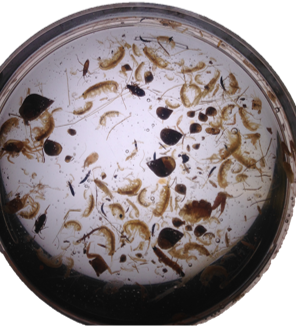

How do you collect macrofauna? Well, that depends on where and why you are collecting these organisms…
In our discussion of the benthic community last week, we focused on macrofauna, organisms larger than 0.5 mm in size and visible without a microscope. These fauna are important to our coastal food webs and comprise the majority of the diet of several commercially and recreationally important species in the Gulf of Mexico like drum and blue crabs. Macrofauna are often separated into infauna and epifauna depending on whether they live in the sediment or on the sediment surface, respectively. (See last week’s Word Wednesday for more detail on the difference between infauna and epifauna).
There are a variety of ways and equipment used to collect macrofauna including hand nets, grabs, cores, sleds, dredges and suction sampling. Methods are chosen with either a particular habitat or particular organisms in mind. For example, a core taken in a seagrass bed would collect infauna and epifauna attached to the leaves or stem, but not more mobile species such as small fish or crabs. The epibenthic sled and suction sampler both collect epifauna, small fish and crabs, but not infauna.
The DISL suction sampler consists of a gasoline powered suction pump, a wand (like the end of your vacuum), a mesh collecting bag and a large plastic cylinder. To collect a sample, the plastic cylinder (also known as a drop sampler), which is open on both ends, is carefully dropped and then pushed firmly into the sediment by several inches in an undisturbed area: it’s always important to collect samples where none of your equipment or people have been! The enclosed contents are then suctioned out through the wand using a process known as the venturi effect, and collected into the 0.5 mm mesh collecting bag to keep all the macrofauna. The venturi effect is based on fluid dynamic principles of physics (for a simple explanation on how it works and to find out how to make your own venturi-style vacuum pump click here to read an article from Makezine.com).

After a specified period of collection time, the pump is turned off and the contents of the bag are rinsed into a 0.5 mm sieve to remove any remaining sediment or plant material. Typically, it takes 3-4 individuals to operate the sampler: one at the pump who is in charge of turning it on and off and timing, one at the collecting bag making sure the bag isn’t getting clogged, and one or two at the cylinder keeping it in place and suctioning with the wand. Samples are then labeled and placed on ice until they make it back to the laboratory. The macrofauna collected will later be sorted, counted and identified to species (or the lowest taxonomic level possible) for measurements of abundance, species diversity and evenness (relative abundance).
ACER scientists in the Wetlands group are currently using a suction sampler to collect macrofauna living within 1 meter of the edge of the salt marsh. This boundary between the salt marsh and open water has been shown to have high abundances of macrofauna that typically occur in salt marshes making it a great location to study organisms that utilize a salt marsh while limiting any damage to the habitat by the sampling process.